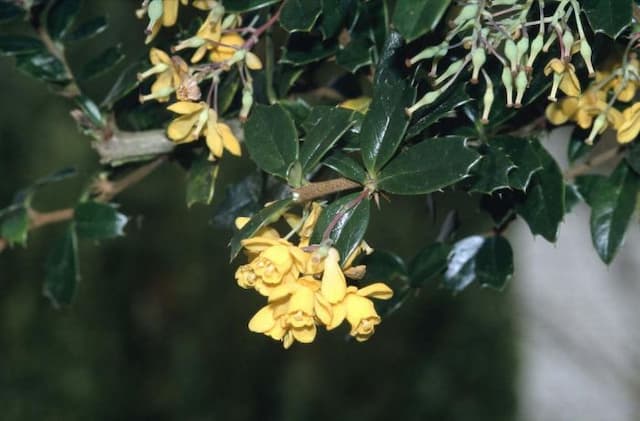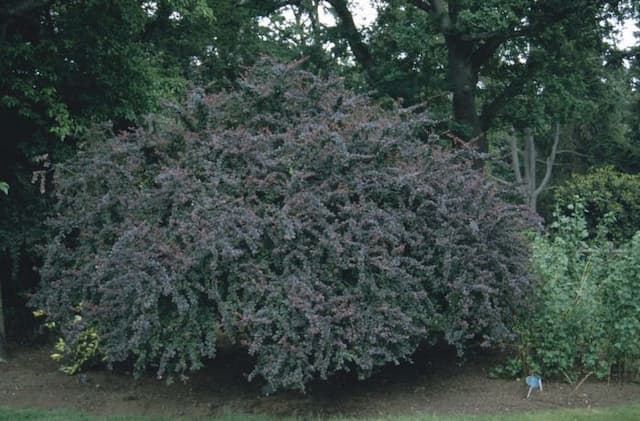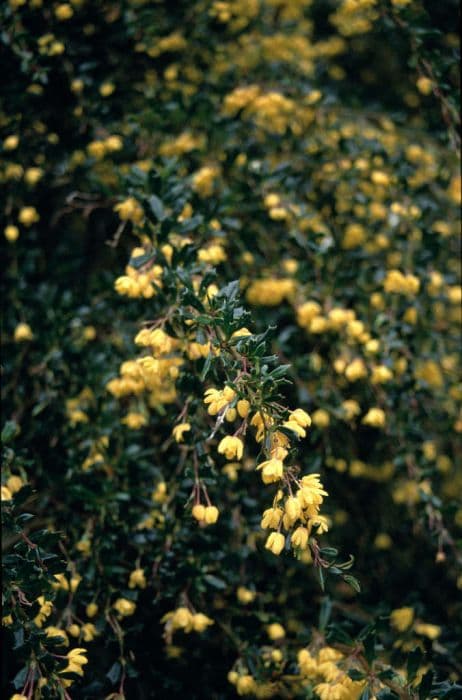Dwarf boxleaf barberry Berberis microphylla 'Pygmaea'

ABOUT
Berberis microphylla 'Pygmaea', also known as Boxleaf Barberry, is a dense, compact evergreen shrub. Its tiny, leathery leaves are a deep green color and often take on a bronze hue in the fall. Despite its small leaf size, the foliage grows in an attractive, neat fashion that provides a fine textured look. The plant is adorned with small, yellow flowers in the spring, which emerge along the stems. These blossoms can attract pollinators and may later turn into small, dark berries that are both bitter to taste and appealing to birds. The stems of Boxleaf Barberry are equipped with sharp thorns that can serve as a deterrent to unwelcome visitors, making the plant effective for use as a low, defensive hedge. The overall form of the Boxleaf Barberry is rounded, with branches that can sometimes arch or spread outward, adding to its ornamental value in a garden setting.
About this plant
 Names
NamesFamily
Berberidaceae
Synonyms
Dwarf Magellan Barberry, Pygmy Barberry, Minature Barberry
Common names
Berberis microphylla 'Pygmaea'.
 Toxicity
ToxicityTo humans
The common name of Berberis microphylla 'Pygmaea' is Dwarf Barberry. Dwarf Barberry is not commonly known to be toxic to humans when touched. However, ingestion of large quantities of the berries or other plant parts might cause mild stomach upset, nausea, vomiting, or diarrhea due to the presence of alkaloids such as berberine. It is always recommended to keep an eye on children and to prevent them from eating any parts of ornamental plants, as individual sensitivity can vary.
To pets
The common name of Berberis microphylla 'Pygmaea' is Dwarf Barberry. Dwarf Barberry is not typically regarded as a highly toxic plant to pets, but it does contain alkaloids such as berberine, which can pose risks if ingested in large quantities. Ingestion of this plant by pets could possibly lead to gastrointestinal upset, including symptoms such as vomiting and diarrhea. Care should be taken to ensure that pets do not consume plant parts, and they should be monitored for any adverse reactions if ingestion occurs.
 Characteristics
CharacteristicsLife cycle
Perennials
Foliage type
Evergreen
Color of leaves
Green
Flower color
Yellow
Height
2 feet (0.61 meters)
Spread
3 feet (0.91 meters)
Plant type
Shrub
Hardiness zones
7
Native area
South America
Benefits
 General Benefits
General Benefits- Compact Growth: Berberis microphylla 'Pygmaea', commonly known as Dwarf Barberry, has a small, compact form ideal for smaller gardens or limited spaces.
- Low Maintenance: Dwarf Barberry is relatively low maintenance, requiring minimal pruning and care once established.
- Drought Tolerant: The plant is well-suited to withstand periods of drought, making it a good choice for xeriscaping and water-conserving landscapes.
- Year-Round Interest: With its evergreen foliage, Dwarf Barberry provides continuous interest throughout all seasons.
- Attractive Foliage: The plant offers ornamental value with its small, glossy green leaves that can turn red or purple in the autumn.
- Wildlife Habitat: It can serve as a habitat for birds, offering them protection with its thorny branches and potentially supplying berries as a food source.
- Erosion Control: The dense growth habit of Dwarf Barberry helps to stabilize soil and prevent erosion on slopes or in areas prone to soil loss.
- Edible Fruit: The plant produces edible berries that can be used in culinary applications, such as making jams or jellies.
 Medical Properties
Medical Properties- This plant is not used for medical purposes.
 Air-purifying Qualities
Air-purifying QualitiesThis plant is not specifically known for air purifying qualities.
 Other Uses
Other Uses- Berberis microphylla 'Pygmaea', commonly known as Boxleaf Barberry, can be used in crafting miniature fairy gardens due to its small, compact form.
- The dense thorny branches of the Boxleaf Barberry make it suitable for use in protective hedges for garden security.
- Its tolerance to pruning allows Boxleaf Barberry to be used in topiary, creating intricate garden shapes and designs.
- The bright red berries of the Boxleaf Barberry serve as attractive winter ornaments for garden accents when other plants have faded.
- The leaves of Boxleaf Barberry can be used in natural dyeing processes, imparting yellowish tones to fabrics and yarns.
- Boxleaf Barberry's thorns can be used as natural toothpicks after removal and proper cleaning.
- During the fall, the foliage turns a brilliant red, making it a desirable plant for photographers seeking autumnal-themed subjects.
- The branches of Boxleaf Barberry can be dried and used in wreaths and other dried flower arrangements for their texture and color.
- The contrasting texture and color of Boxleaf Barberry leaves make it suitable as a backdrop for photographing small objects for increased visual interest.
- Used to create low-maintenance container gardens, Boxleaf Barberry provides structure and winter interest with minimal care requirements.
Interesting Facts
 Feng Shui
Feng ShuiThe Magellan Barberry is not used in Feng Shui practice.
 Zodiac Sign Compitability
Zodiac Sign CompitabilityThe Magellan Barberry is not used in astrology practice.
 Plant Symbolism
Plant Symbolism- Protection: Berberis microphylla 'Pygmaea', commonly known as Boxleaf Barberry, has sharp thorns that are believed to symbolize protection and deterrence from negativity or harm.
- Purification: The plant has been associated with purification because it has been used historically in herbal medicine to cleanse the body and fight infections.
- Adaptability: Given its ability to thrive in challenging environments, the Boxleaf Barberry symbolizes adaptability and resilience in the face of adversity.
 Water
WaterDwarf barberry prefers consistent moisture, but it is drought tolerant once established. Water the plant deeply once a week, providing about 1 inch of water each time, which equates to approximately 0.6 gallons per square foot of soil area. During hotter, dryer periods, check the soil moisture and water additionally if the top 2 inches of soil are dry. In cooler, wet seasons, reduce the frequency to prevent overwatering. Adjust watering for rainfall, ensuring the plant is not left in waterlogged soil as this can cause root rot.
 Light
LightDwarf barberry thrives in full sun to partial shade. The ideal spot for this plant would receive at least six hours of direct sunlight but is also tolerant of shaded conditions for some part of the day. Avoid deep shade as it can lead to a sparse growth habit and fewer flowers and berries.
 Temperature
TemperatureDwarf barberry is hardy and can withstand temperatures as low as -20°F, but the ideal temperature range for robust growth is between 60°F and 70°F. During extreme summer heat above 86°F, ensure the plant is well-watered to prevent stress. This tough shrub can tolerate a wide range of temperature fluctuations.
 Pruning
PruningPrune dwarf barberry in late winter or early spring to remove any dead or damaged wood and to maintain its compact shape. It doesn't require frequent pruning, but an occasional trim can encourage denser foliage. The best time for a more significant pruning is immediately after flowering to shape the plant without sacrificing the next season's blooms.
 Cleaning
CleaningAs needed
 Soil
SoilBoxleaf Barberry ('Pygmaea') thrives in well-draining soil rich in organic matter with a pH range between 5.5 and 7.5. A good soil mix can be created by combining equal parts of garden soil, peat moss or well-rotted compost, and coarse sand to improve drainage.
 Repotting
RepottingBoxleaf Barberry ('Pygmaea') should be repotted every 2 to 3 years, or once it becomes root-bound. Choose a slightly larger pot each time to accommodate root growth.
 Humidity & Misting
Humidity & MistingBoxleaf Barberry ('Pygmaea') is tolerant of a wide range of humidity levels, but it typically prefers moderate humidity. No specific humidity level is critical for its growth.
 Suitable locations
Suitable locationsIndoor
Place in bright light, water moderately.
Outdoor
Full sun to part shade, well-drained soil.
Hardiness zone
6-10 USDA
 Life cycle
Life cycleBerberis microphylla 'Pygmaea', commonly known as Dwarf Magellan Barberry, starts its life from seed, which germinates in favorable conditions of light and temperature. The seedling emerges and establishes a root system, gradually developing into a juvenile plant with small, evergreen leaves. As it matures, the Dwarf Magellan Barberry enters the vegetative stage, forming a compact shrub with dense foliage and characteristic spines on the branches. During spring, it produces yellow, fragrant flowers which attract pollinators. After pollination, the plant develops small, edible berries that ripen to red or blue, depending on the specific variety, and these fruits may be dispersed by birds, which helps in seed dispersal. The plant continues to grow and can enter a period of dormancy in colder months, resuming active growth with the return of warmer conditions.
 Propogation
PropogationPropogation time
Spring-summer
The common name for Berberis microphylla 'Pygmaea' is Dwarf Boxleaf Barberry. One popular method for propagating this plant is through semi-hardwood cuttings. This takes place typically during late summer. To propagate by this method, cut a 4 to 6-inch (10 to 15 cm) portion of the stem that is not overly rigid or overly flexible. Remove the leaves from the lower half of the cutting and dip the end into rooting hormone. Plant the cutting into a well-draining soil mix, and keep it consistently moist. Place the pot with the cutting in a warm, shaded area until roots develop, after which it can be transplanted into the garden.









